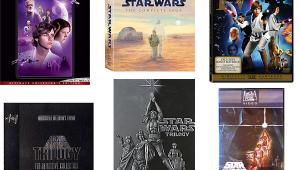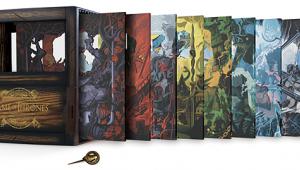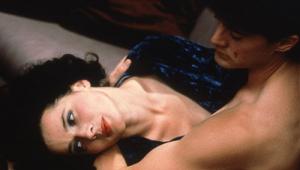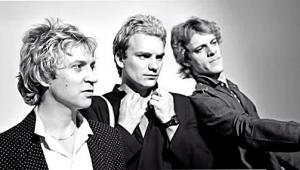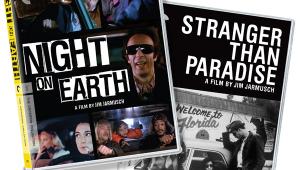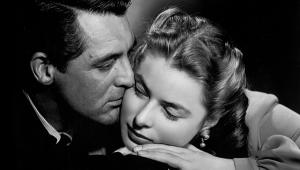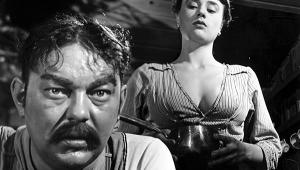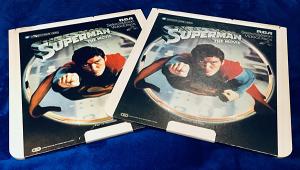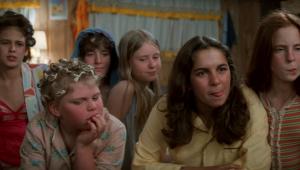This Week in Movies & TV, September 10, 2013: Explorers, Spies, & Imposters

Star Trek Into Darkness
In this, the second Star Trek tour for producer-director J.J. Abrams, the 12th installment in the Star Trek film franchise, the crew of the Enterprise is sent to the Klingon homeworld seeking former Starfleet member-turned-super-man-terrorist John Harrison/Khan (Benedict Cumberbatch). With a personal score to settle, Captain James T. Kirk (Chris Pine) leads the manhunt into hostile territory only to discover there’s a lot more to this supposedly simple scenario than meets the eye.
Suit up. Because about 30 minutes of the film — much of the rollercoaster-ride action sequences that unfold outside the Enterprise — were shot in IMAX, the huge 15-perf IMAX format which captures a negative image nearly 10 times the area of a standard 35mm frame. (In order to make a consistent aspect ratio, in post-production the middle part of the more-square 1.66:1 IMAX frame was extracted and intercut with the widescreen, 2.35:1 images.)
The IMAX images have extremely rich, vibrant, but very well defined colors such as the cerise, red-pink trees in the opening sequence on Nibiru and the costumes of the indigenous race. There’s great clarity to these images, the faces of these tribesmen being incredibly detailed, finely shaded and textured. Blacks in Spock’s hair, the crew neck sweaters of the . . . crew, and kinky boots are deep and whites, in Bone’s gowns, Sickbay sheets, and transporter beams, are bright. Images in the forest have great depth and dimensionality with layers upon layers of trees going deep into the background. There’s much volume to figures and faces in such scenes, with an almost tactile roundness to them.

The only trouble with this is that I found myself wanting to hurry along the expositional sequences, not just because they tend to drag a bit, but to get back to stunning quality of the IMAX-shot visuals. The regularly-shot images on board the Enterprise, although perfectly fine by current film standards, offering saturated tones in the mustard, blue, and crimson uniforms and generally good contrast, have a relative softness and lack the resolution of their IMAX cousins, figures not having the same solidity and faces appearing quite flat.
Right from the get-go the music fills 5.1 channels of the 7.1 mix, the rears being employed almost exclusively for atmospherics — creatures of the forest in the opening scene, murmuring voices and humming of engines in Star Base, and weeeeeee-oooh electronic whistle signaling a now-hear-this announcement. The other way they’re used is in the creation of accurately panned effects, such as the many ship flybys — overhead and diagonally across from front right to back left — and, in a pitch battle, phaser blasts from all around you.

Michael Giacchino’s magnificent orchestral score, sometimes bombastically rousing, at others mesmerizing with Philip Glass-like repetitive minimalism, comes at you in waves of strings from all sides interspersed with mournful piano from the center accented by militaristic snare drumming from the surrounds or pounding kettle drums from the front left. It’s always interesting and gripping as it carries you along with the action or pensively builds tension in the more thoughtful or moving scenes. The soundtrack as a whole, with its excellent mix of well-separated instruments, is very immersive yet very open with well-defined elements. It’s full and clear with a wide dynamic range, LFEs abounding in rumbling volcano, throbbing ships, and ominous deeply resonating elements to the score. Voices are crisp and always easy to understand, Peter Weller’s gravely snarl sonorous and solid.
I’m still flabbergasted when Pine channels young Kirk, getting his intonation perfectly, without exaggeration, nailing the loveable smirk and twinkle in the eye or sudden change of pace. The rest of the cast in this action-and-ILM effects sci-fi spectacular includes Zachary Quinto as Spock, Karl Urban as Bones, Simon Pegg as Scotty, Zoe Saldana as Uhura, and Anton Yelchin as Chekov — all of whom recreate the old original series actors’ portrayals magnificently.
Star Trek Into Darkness grossed more than $462 million worldwide, making it the highest-grossing film of the Star Trek franchise.

The extras included here were produced entirely by Abrams and shot on Red Epic HD cameras.
Star Trek Into Darkness is also available in a Blu-ray 3D set (the film was converted to 3D in post-production) that comes with 2D Blu-ray, DVD, and UltraViolet digital copy for streaming/downloading.
A 3D Starfleet Phaser Limited Edition Gift Set with all that’s included in the 3D set plus a 1:1 scale replica of the Starfleet phaser (with “stun” or “kill” settings), a gloss black display stand, and a brass plaque is also available.
Video: 2.40:1. Audio: Dolby TrueHD 7.1. Extras: “Creating the Red Planet,” “Attack on Starfleet,” “The Klingon Home World,” “The Enemy of My Enemy” (on the film’s villain), “Ship to Ship” (on the space jump sequence), “Brawl by the Bay” (on the climax), and “Continuing the Mission” (on the partnership between the film’s crew and the organization that assists returning veterans) featurettes; DVD and UltraViolet digital copy for streaming/downloading. Studio: Paramount.

Star Trek: Stardate Collection
The 12-disc box set combines the previously released Star Trek: Original Motion Picture Collection and the Star Trek: The Next Generation Motion Picture Collection into one comprehensive package. The 10 original Star Trek films spanning from 1979 to 2002 include Star Trek: The Motion Picture, Star Trek II: The Wrath of Khan, Star Trek III: The Search for Spock, Star Trek IV: The Voyage Home, Star Trek V: The Final Frontier, Star Trek VI: The Undiscovered Country, Star Trek: Generations, Star Trek: First Contact, Star Trek: Insurrection, andStar Trek: Nemesis. In addition there are 25 hours of extras, 15 hours of them available on the Blu-ray set but not the DVD version of the set.
All, Video: 2.35:1. Audio, first 6 films: Dolby Digital TrueHD 7.1. Audio, last 4 films: Dolby Digital TrueHD 5.1. Extras, The Motion Picture: commentary by Michael & Denise Okuda, Judith & Garfield Reeves-Stevens, and Daren Dochterman, “The Longest Trek: Writing The Motion Picture,” “SpecialStar Trek Reunion,” and “Starfleet Academy: The Mystery Behind V’ger” featurettes, deleted scenes, storyboards. Extras, The Wrath of Khan: commentary by director Nicholas Meyer, commentary by director Nicholas Meyer and Manny Coto, “Designing Khan,” “Where No Man Has Gone Before: The Visual Effects of Star Trek II: The Wrath of Khan,” and “A Tribute to Ricardo Montalban” featurettes, original interviews with DeForest Kelley, William Shatner, Nimoy and Ricardo Montalban. Extras, The Search for Spock: commentary by director Nimoy, writer-producer Harve Bennett, director of photography Charles Correll, and actress Robin Curtis, commentary by Ronald D. Moore and Michael Taylor, “Terraforming and the Prime Directive,” “Industrial Light & Magic: Visual Effects,” “Spock: The Early Years,” and “Speaking Klingon” featurettes, photo gallery, storyboards.

Extras, The Voyage Home: commentary by Shatner and Nimoy, commentary by Roberto Orci and Alex Kurtzman, “Future's Past: A Look Back,” “Pavel Chekov's Screen Moments,” and “The Three-Picture Saga” featurettes, original interviews with Nimoy, Shatner and Kelley, Roddenberry scrapbook, production gallery, storyboards. Extras, The Final Frontier: commentary by William Shatner and Liz Shatner, commentary by Michael & Denise Okuda, Judith & Garfield Reeves-Stevens, and Daren Dochterman, “The Journey: A Behind-the-Scenes Documentary,” “Herman Zimmerman: A Tribute,” “Original interview: William Shatner,” “Star Trek Honors NASA,” and “Hollywood Walk of Fame: James Doohan” featurettes, deleted scenes, production gallery, storyboards. Extras,The Undiscovered Country: commentary by director Nicholas Meyer and screenwriter Denny Martin Flinn, commentary by Larry Nemecek and Ira Steven Behr, “Farewell & Goodbye,” “Conversations with Nicholas Meyer,” “To Be Or Not To Be: Klingons and Shakespeare,” and “DeForest Kelley: A Tribute” featurettes, original interviews, production gallery, storyboards. Extras, Generations: commentary by director David Carson and Manny Coto, commentary by Brannon Braga and Ronald D. Moore, “Uniting Two Legends,” “Strange New Worlds: The Valley of Fire,” “Scene Deconstructions,” “A Tribute to Matt Jefferies,” and “Captain Picard’s Family Album” featurettes, deleted scenes, storyboards, production gallery.

Extras, First Contact: commentary by director and actor Jonathan Frakes, commentary by screenwriters Brannon Braga and Ronald D. Moore, commentary by Damon Lindelof and Anthony Pascale, “Making First Contact,” “Jerry Goldsmith: A Tribute,” “Greetings from the International Space Station,” “Trek Roundtable: First Contact,” and “The Borg Collective” featurettes, scene deconstructions, storyboards, photo galleryExtras, Insurrection: commentary by Jonathan Frakes and Marina Sirtis, “Making Star Trek: Insurrection,” “The Art of Insurrection,” “Director’s Notebook,” and “Westmore’s Legacy” featurettes, deleted scenes, storyboards, photo gallery. Extras, Nemesis: commentary by director Stuart Baird, commentary by producer Rick Berman, commentary by Michael & Denise Okuda, “Nemesis Revisited,” “A Star Trek Family’s Final Journey,” “Reunion with the Rikers,” and “Today's Tech Tomorrow’s Data” featurettes, deleted scenes, storyboards. Extras, Star Trek Summit Bonus Disc: “Parts 1–3” “Evolutions Bonus Disc,” “The Evolution of the Enterprise,” “Villains of Star Trek,” I Love the Star Trek Movies,” “Farewell to Star Trek: The Experience,” “Klingon Encounter,” “Borg Invasion 4D,” and “Charting the Final Frontier” featurettes. Extras, Evolutions Bonus Disc: “The Evolution of the Enterprise,” “Villains of Star Trek,” “I Love the Star Trek Movies,” “Farewell to Star Trek: The Experience,” “Klingon Encounter,” “Borg Invasion 4D,” and “Charting the Final Frontier” featurettes. Studio: Paramount.

The Spy Who Came In From The Cold
Adapted from the highly acclaimed, best-selling novel by John le Carré (Tinker Tailor Soldier Spy, The Tailor of Panama, The Constant Gardener), The Spy Who Came In From The Cold (1965) tells of Alec Leamas (Richard Burton giving a pitch-perfect performance), a bitter, world-weary, burnt-out British SecretIntelligenceService field agent during the Cold War.
After a mission goes wrong and the agent he was supposed to get out of East Berlin is shot, Leamas meets with his boss, Control (Cyril Cusack), in London, expresses his disdain for the job, and soon after quits the service. After a time, he gets a low-level job working in a local library by day whilst spending the evenings drinking himself to death. He attracts the attention of a beautiful and sympathetic librarian

Nan Perry (Claire Bloom) whom, after Leamas does a spell in stir for beating up a greengrocer, he becomes romantically involved with. He also attracts the attention of a stranger who wants to give him a lot of money to tell all he knows about the British secret service and the missions he’s been involved in.
Leamas, with nothing to lose and seemingly disillusioned to the point of having no loyalties to any side, agrees to the deal and is taken to East Germany to be interrogated first by Fiedler (Oskar Werner) and then by his boss, Mundt (Peter Van Eyck) — the man responsible for the death of the agent Leamas tried to get out of East Berlin.

Director Martin Ritt (Hud, The Front, Norma Rae) brings his considerable dramatic talent to bear in creating a cinematic adaptation that captures the atmosphere and tone of the book and is every bit as tensely precise, hard-edged, and tragic, maintaining all its political and social consciousness in its questioning of the East–West conflict.
The Spy Who in from the Cold was nominated for Oscars for Best Actor in a Leading Role (Richard Burton) and Best Art Direction-Set Decoration, Black-and-White. It was beautifully shot in noirish tones by cinematographer Oswald Morris (Lolita, The Guns of Navarone, The Pumpkin Eater).

The high-definition transfer was created from a 35mm composite fine-grain master positive and all dirt and damage digitally removed or fixed. The original stereo soundtrack was remastered at 24-bit from a 35mm optical soundtrack print and hiss, clicks, and other faults digitally fixed.
Video: 1.66:1. Audio: Linear PCM 2.0 Stereo. Extras: interview with le Carré, selected-scene commentary by Morris, The Secret Centre: John le Carré 2000 BBC documentary on the author’s life and work, interview with Burton from a 1967 episode of the BBC series Acting in the ’60s by critic Kenneth Tynan, audio conversation from 1985 between Ritt and film historian Patrick McGilligan, gallery of set-design stills, booklet featuring an essay by critic Michael Sragow. Studio: The Criterion Collection.

The Talented Mr. Ripley
In this 1999 psychological thriller from writer-director Anthony Minghella (The English Patient, Cold Mountain, Breaking and Entering), Tom Ripley (Matt Damon) is a bright but calculating young man, used to making his way in the world not by being all he can be, but by being who people think him to be or would like him to be.
We find Tom working as a men’s room attendant and occasionally as a pianist to support himself in mid-1950s New York City, though his natural range of talents lie in impersonations, forging handwriting, and in playing small-time confidence tricks.

After pretending that, yes, he is indeed a Princeton student as his (borrowed) tie suggests, Tom gets an offer from shipping tycoon Herbert Greenleaf (James Rebhorn), father of playboy Dickie Greenleaf (Jude Law), a presumed classmate of Tom. Dickie has swanned off to the Italian coast to laze around living a carefree life with his beautiful fiancée, Marge Sherwood (Gwyneth Paltrow) on his father’s dime. Dickie’s father says he’ll pay Ripley $1,000 plus expenses if he’ll go to Italy and persuade his “classmate” to return home.
Tom, sensing an opportunity, takes up the offer and, by concocting an accidental meeting on the beach, insinuates himself into Dickie’s life. Gauche Tom and charismatic, golden-boy Dickie become friends, bound together by a supposed shared love of jazz. Tom soon finds himself both attracted to Dickie and envious of his lifestyle and in time he decides that he’d rather be Dickie Greenleaf than carry on as poor, unglamorous Tom Ripley.
All goes well in the substitution until he’s tracked down by the Dickie’s suspicious best friend, Freddie Miles (Philip Seymour Hoffman giving his best, most charismatic performance), who doesn’t trust Tom or believe in his story of Dickie’s disappearance.

And then, as fate would have it, Tom runs into Meredith Logue (Cate Blanchett), an heiress he’d charmed on the boat over who knows him as Tom Ripley not the Dickie Greenleaf he’s now passing himself off as, leaving Tom with a horrible dilemma and an inevitable path he won’t be able to return from.
The Talented Mr. Ripley was nominated for five Oscars including Best Supporting Actor (Law), Best Adapted Screenplay Minghella), Best Original Score (Gabriel Yared), Best Art Direction, andBest Costume Design.
Video: 1.85:1. Audio: DTS-HD Master Audio 5.1. Extras: director’s commentary, “Inside The Talented Mr. Ripley,” “Reflections on The Talented Mr. Ripley,” and The Making of the Soundtrack” featurettes. Studio: Warner.

Parade’s End
Director Susanna White’s 5-part, 5-hour BBC/VRT (Flemish TV)/HBO miniseries Parade's End was adapted by playwright/screenwriter Tom Stoppard (Shakespeare in Love, Brazil, Empire of the Sun) from a tetralogy of novels by Ford Madox Ford published in the 1920s. It tells of a tumultuous 10-year span, from the dying days of Edwardian England with its brilliant yet empty world of London high society, to the chaos and destruction of World War I in the trench-scarred battlefields of France, a period when old ways and certainties were all suddenly being called into question, and a way of life lost, never to return again.
An English aristocrat Christopher Tietjens (Benedict Cumberbatch) decides to do the honorable thing by marrying Sylvia (Rebecca Hall) — a beautiful but vindictive and manipulative socialite — even though the child she’s pregnant with may not be his.

Soon Tietjens is having to endure not only his new wife’s cruel moods and whims, but also her obvious indiscretions, yet, despite finding himself becoming enamored of a brave young suffragette, Valentine Wannop (Adelaide Clemens) — someone who reciprocates his feelings — Tietjens is determined to remain loyal to his wife and make the marriage work.
Over the course of the decade, Tietjens experiences war first hand along with the far-reaching changes that are revolutionizing English society leading him to gradually questions the traditions and decisions that have previously bound him.
Parade's End co-stars Rupert Everett, Miranda Richardson, Roger Allam, Anne-Marie Duff, Stephen Graham, and Janet McTeer.
Video: 1.78:1. Audio: DTS-HD Master Audio 5.1. Extras: Tom Stoppard interviewed by Elvis Mitchell; iTunes digital copy. Studio: HBO.

La Cage aux Folles
In the wise and warmhearted French farce, La Cage aux Folles (Birds of a Feather, 1978), by director Edouard Molinaro (Beaumarchais the Scoundrel, Oscar, My Uncle Benjamin), Renato (Ugo Tognazzi) is the owner of La Cage aux Folles, the wildest, glitziest drag club in St. Tropez, and his romantic partner Albin (Michel Serrault), is the club’s star. This middle-aged gay couple is delighted at the news that Renato’s son, Laurent Baldi (Rémi Laurent) — the outcome of an early experimental tryst with a woman — intends to marry a lovely girl (Luisa Maneri). However, they’re less enthusiastic at Laurent’s plea that when they meet the girl's ultraconservative parents, his father and Albin not be themselves — that they act like normal people.

This is quite a dilemma, since it not only entails agreeing to give up their principles to play straight to appease the world, but, given their line of work, having to assume completely new identities, change their home decor, and hide their friends. And just how will the highly flamboyant Albin possibly be able to act out his new part convincingly?
This modest French comedy on the importance of nonconformity and being true to yourself, based on the 1973 play by Jean Poiret, became a breakout art-house hit in America, was nominated for three Oscars — Best Director, Best Writing (Screenplay Based on Material from Another Medium), and Best Costume Design —and inspired a major Broadway musical.

La Cage aux Folles was shot by cinematographer Armando Nannuzzi and the soundtrack was composed by the great Ennio Morricone (Before the Revolution, A Fistful of Dollars, For a Few Dollars More, The Hawks and the Sparrows, The Battle of Algiers, Teorema, The Good, the Bad and the Ugly, Once Upon a Time in the West, Burn!, Investigation of a Citizen Above Suspicion, Two Mules for Sister Sara, The Bird with the Crystal Plumage, The Decameron, Four Flies on Grey Velvet, The Canterbury Tales, Arabian Nights, 1900, Exorcist II: The Heretic, Days of Heaven, Tragedy of a Ridiculous Man, The Thing, White Dog, Once Upon a Time in America, The Untouchables, Frantic, Cinema Paradiso, Casualties of War, Fat Man and Little Boy, Tie Me Up! Tie Me Down!, In the Line of Fire, The Stendhal Syndrome, and almost 500 other titles).

This transfer comes from a new 2K digital film restoration and has an uncompressed mono soundtrack.
Video: 1.66:1. Audio: French, Linear PCM Mono. Extras: new interview with director Molinaro, archival footage featuring actor Serrault and Jean Poiret (writer and star of the original stage production of La Cage aux Folles), new interview with The Changing Room: Sex, Drag and Theatre author Laurence Senelick, booklet featuring an essay by critic David Ehrenstein. Studio: The Criterion Collection.

Marathon Man
This classic 1976 suspense thriller was adapted by screenwriter William Goldman (Butch Cassidy and the Sundance Kid, All the President's Men, Misery) from his own novel and directed by John Schlesinger (Midnight Cowboy, Darling, Sunday Bloody Sunday).
When the brother of a Nazi war criminal is killed in a traffic accident in New York, Doc Levy (Roy Scheider), an American (agent) in Paris who belongs to a covert US government group called “The Division,” travels to New York in the hope that escaped Nazi war criminal Szell (Laurence Olivier) will be tempted out of his South American hiding place to recover and sell off a valuable cache of diamonds which he’d gathered from Jews in Auschwitz before they were murdered. Shortly thereafter, members of The Division, one by one, begin dying.

Doc meets up with his younger brother, Babe (Dustin Hoffman), a history Ph.D. candidate pacifist innocent, and avid runner, and suspects his brother’s girlfriend is working for Szell. After confronting Szell, in the process getting wounded, Doc staggers to Babe’s apartment and collapses without telling him anything. Szell, who is trying to wrap up loose ends in his diamond dealings and ensure that no one knows his identity, has Babe kidnapped and brought to him. Then the former SS dentist Szell, The White Angel of Auschwitz, asks the immortal question, “Is it safe?”
Marathon Man co-stars William Devane, Marthe Keller, and Fritz Weaver.
Video: 1.85:1. Audio: DTS-HD Master Audio 5.1, Dolby Digital 2.0. Extras: “The Magic of Hollywood . . . Is the Magic of People” 21-minute making-of featurette with producer Robert Evans, “Remembering Marathon Man,” 30-minute featurette with Hoffman, Scheider, Keller, and Goldman sharing their memories, 21 minutes of rehearsal footage. Studio: Warner.
- Log in or register to post comments


